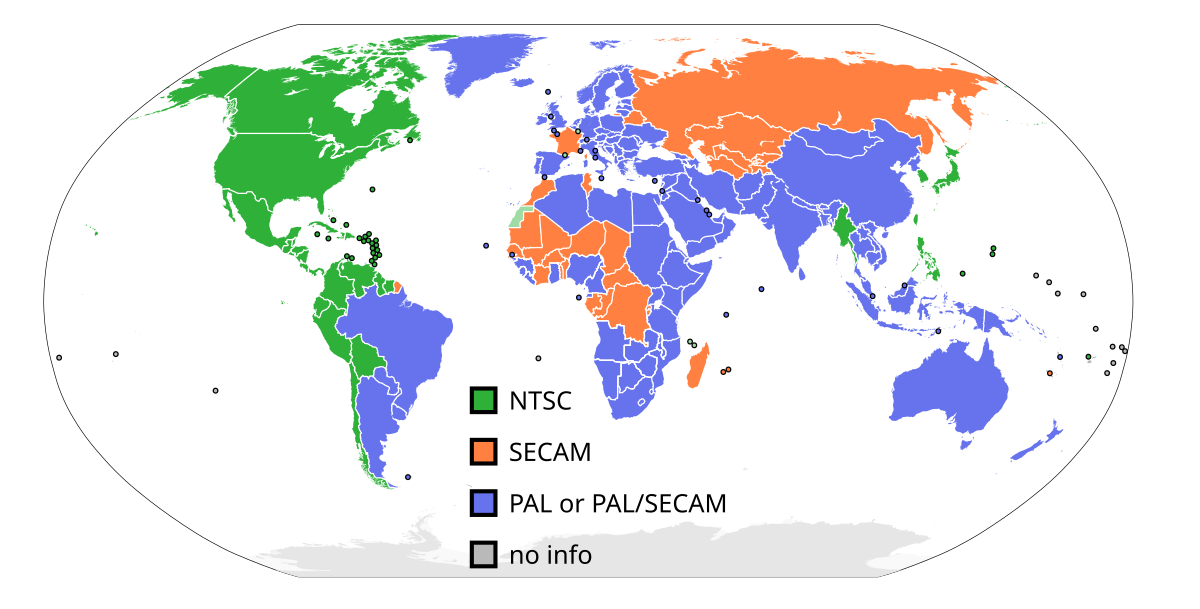PAL, which stands for Phase Alternating Line, is a color encoding system used in analog television broadcasts and video formats in various parts of the world. It is one of the three main color systems, alongside NTSC and SECAM, that developed in the 20th century to transmit color video over airwaves. While PAL was originally designed for traditional television broadcasts, its usage extends to security cameras, DVD players, and video production equipment in regions that adopt this standard. Understanding the PAL format is essential for setting up compatible video devices and ensuring smooth video playback, especially in international contexts where different standards are used.
Meaning
PAL (Phase Alternating Line) is an analog color television encoding system that was developed in the early 1960s. It was designed to address some of the issues with the earlier NTSC system, particularly color inconsistencies. The "phase alternating" aspect refers to the way the color signal alternates its phase on every other line, which helps reduce color errors and provides a more accurate display of hues.
PAL broadcasts video using 625 lines per frame, and it has a refresh rate of 25 frames per second (FPS), interlaced. This means the image is refreshed 50 times per second, but only half of the lines (odd or even) are displayed during each refresh, creating a smooth video playback at 25 complete frames per second. PAL is known for its better color fidelity and higher resolution compared to NTSC, although NTSC is more commonly used in North America and Japan.
Which Countries Use PAL System?

PAL is predominantly used in Europe, Africa, Asia, and parts of South America and Oceania. Some of the major countries and regions that use or have historically used the PAL system include:
- Europe: United Kingdom, Germany, Italy, Spain, France (for certain regions), and most other European nations.
- Africa: South Africa, Egypt, Kenya, and many others.
- Asia: India, China, Australia, New Zealand, Singapore, Hong Kong, and the Middle East countries.
- South America: Brazil (though a hybrid version called PAL-M), and other countries like Argentina use PAL-N.
PAL is the dominant video standard in these regions, especially for traditional analog television. However, with the advent of digital broadcasting, PAL is gradually being phased out in favor of digital systems like DVB (Digital Video Broadcasting) or ISDB.
What is a PAL Format Security Camera?
A PAL format security camera is a surveillance camera designed to record and transmit video using the PAL color encoding system. These cameras are typically found in regions where PAL is the standard for video equipment, particularly in Europe, Asia, and parts of Africa. When used with a compatible PAL recorder or display, these cameras provide smooth video playback with accurate color reproduction.
PAL security cameras offer 625 horizontal scan lines per frame, giving them slightly better resolution compared to NTSC cameras, which have only 525 lines. For this reason, PAL cameras may produce clearer images, especially in wide or expansive areas. However, these cameras are not directly compatible with NTSC-based systems, and converters may be needed if using PAL cameras in NTSC regions like the US.
PAL Resolution
The PAL system operates with a resolution of 720x576 pixels. This resolution applies to standard-definition (SD) analog television signals, and it remains consistent for many analog PAL-based devices like VCRs and older security cameras.
In comparison, the NTSC system has a resolution of 720x480 pixels, which gives PAL a slightly better vertical resolution, offering more detail in the image. The higher resolution in PAL means it can be particularly beneficial for applications like video surveillance, where clarity and detail are crucial for identifying objects and individuals.
PAL Frame Rate
The PAL format uses a frame rate of 25 frames per second (FPS). This is tied to the 50 Hz power grid frequency in most regions that use PAL. Unlike the NTSC format, which runs at 30 FPS (due to the 60 Hz power grid), the lower frame rate of PAL can give video a slightly different, often smoother appearance when compared to NTSC.
For interlaced video, the 25 FPS is achieved by displaying 50 fields per second, alternating between odd and even scan lines. This interlacing helps create the illusion of fluid motion, even though only half the lines are refreshed at any given time.
Advantages and Disadvantages
Advantages of PAL
-
Higher Resolution: PAL’s 720x576 resolution offers a better vertical resolution than NTSC, allowing for clearer images.
-
Color Accuracy: PAL's alternating color phase helps reduce color distortion and improve color fidelity. This makes it especially useful for broadcast and video recording in regions with varying electrical grid stability.
-
Consistency: Since PAL operates at a steady 25 FPS, the video often appears more consistent and smooth in regions using 50 Hz power, without issues like flickering that can happen with NTSC in certain environments.
Disadvantages of PAL
-
Incompatibility: PAL is not compatible with NTSC equipment without converters. This means that videos recorded or broadcast in PAL will not play correctly on NTSC devices, and vice versa. This can be problematic when traveling or sharing media internationally.
-
Lower Frame Rate for Fast Motion: PAL’s 25 FPS frame rate can struggle with fast-moving scenes, which are smoother in NTSC's 30 FPS system. This can lead to slight motion blur during high-speed action.
-
Decline in Use: With the global shift toward digital formats, PAL is becoming less relevant in many regions. Countries are increasingly adopting digital standards like DVB or HDTV, which have rendered the analog PAL system obsolete.
FAQ
PAL, or Phase Alternating Line, is a robust video encoding system that has played a significant role in television and video recording. Although it is being replaced by digital formats, its legacy continues in various video applications, particularly in regions where it has long been the standard. Whether you're working with video production, security systems, or older devices, understanding PAL is key to ensuring compatibility and quality in your video projects.
















